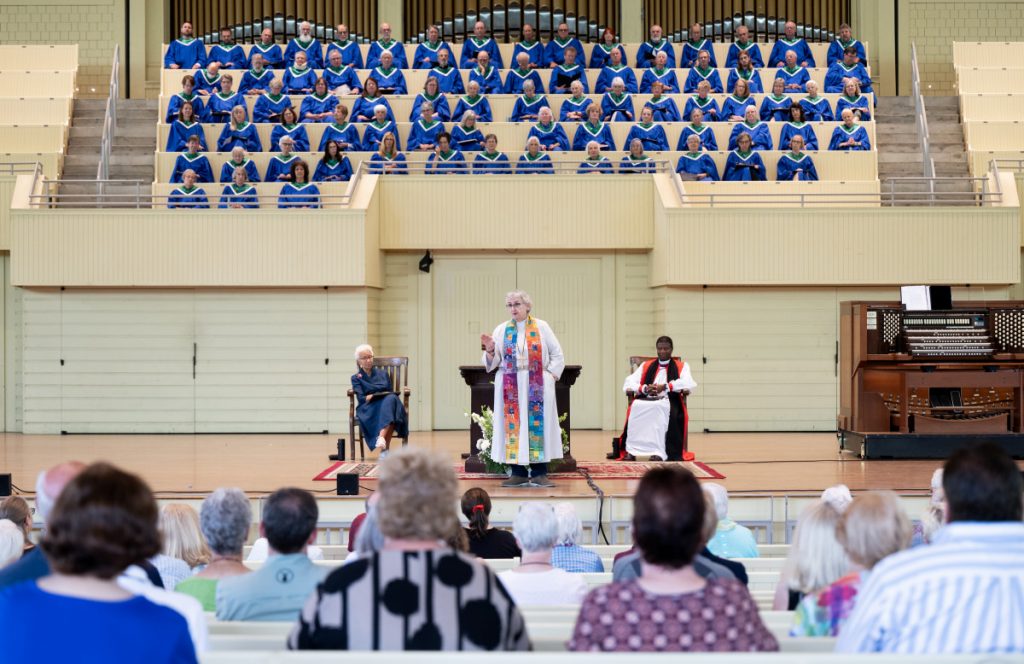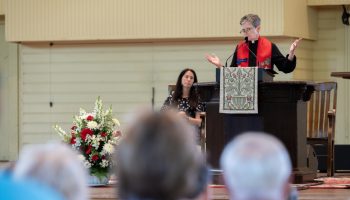
Column by Stacey Federoff
On Dec. 7, 1972, astronauts on the Apollo 17 spacecraft took what would become one of the most widely distributed photographic images in existence — and it happened quite by accident.
NASA and the team had planned each experiment and research effort very carefully. However, explained the Rev. Karyn L. Wiseman, one of the cameras on the back of the craft hadn’t moved when it was supposed to, which led to the creation of the now-iconic image of Earth. Wiseman preached at the 9:15 a.m. Wednesday morning worship service. Her sermon title was “Treasures of the Heart,” and the scripture reading was Matthew 6:19-24.
“NASA was extremely surprised by this picture,” she told the congregation. “It was the first image that any human had ever seen the planet where we live.”
She continued, “You can look down and see the ground, you can go up and see the sky, you can go underwater or on top of the water … you can till the earth and become a farmer, you can fly high” — but this image, with its richly blue oceans and green and brown land covered by swirling white clouds, came to be known as the “Big Blue Marble” for its never-before-seen perspective.
Most images people create have other people in them or are person-oriented — whether famous paintings centuries ago or selfies with the Liberty Bell in modern times — but not this one, Wiseman said: “One of the things we see in this is not us.”
Additionally, the photo helps to emphasize how much of Earth is covered in water, and how vital it is for living things on the planet: “We’re reminded that it’s water that keeps us moving,” Wiseman said. Not only do people need water for utility, such as brushing teeth or cleaning clothes, but also for recreation and enjoyment, Wiseman said.
“We enjoy the water around us … so we make plans of where we’re going to go next,” she said. She and her wife Cindy want to plan a trip to Alaska, but there are places that are no longer the same as they were during the time of the Big Blue Marble photo, because the snow and ice have melted.
Wiseman referenced speakers on the Week Seven theme, “The National Parks: How America’s ‘Best Idea’ is Meeting 21st-Century Challenges,” who have shown images of places across the country impacted by climate change and a warming planet.
Wiseman said these verses from Matthew remind us that “there’s treasure in the world … that we think, ‘If I have that, I’ll know I have made it.’ ”
But, Jesus told the disciples that what they acquire in worldly treasure is “not going to matter a hill of beans. It’s not going to make any difference,” she said. “What’s important is to invest and be in the midst of what your heart longs for.”
Recently, as part of long-term financial investing, money can be directed to funds focused specifically on environmental, social and corporate governance, or ESG, Wiseman explained.
These ESGs allow people to invest in preserving the “finite, fragile amount” of natural treasure here on Earth, she said.
Wiseman continued, “The ice caps are melting, rivers are being ruined by toxic chemicals, glaciers are falling … animals are going extinct because they are in environments where there is no possibility for them to exist the way they used to.”
All of this is contained on the Big Blue Marble that “blew those astronauts and NASA scientists away … to see it hanging in the sky, turning on its axis,” Wiseman said.
And that helped them and other people take the time, with intentionality, she said, to see it — and, subsequently, illustrate to some the imperative to preserve it.
Wiseman paraphrased cosmologist Carl Sagan referring to the 1989 “Pale Blue Dot” image of Earth portrayed as no more than a tiny speck: “Look at that marble. Everyone you love, everything that you hold dear, every environment that you enjoy visiting … every resource is on that marble.”
She continued, “As it hangs there, you see that marble as it marvels us all, as it rotates, moves, gives us food to eat and drink — and we are doing everything we can to destroy it.”
National parks have been set aside so humans can enjoy nature and protect the natural habitat of animals. And, while Jesus said “your heart ought to be up in heaven,” Wiseman said, that doesn’t mean he wanted people to exploit the resources on Earth by doing things like overfishing the oceans or deforesting the land.
“We only have one Big Blue Marble,” she said. “And it was gifted to us by God, who made it, and all the different pieces of it, blessed it, and said, ‘It is good.’ ”
Wiseman had the congregation repeat that phrase: “It is good.”
She continued, “The Big Blue Marble has to be cared for, and that is the lesson we’re learning this week.” God says “it is good,” every single day to everyone and everything on this planet, and God is with us, wherever we are on this planet, Wiseman said.
As stewards of the planet, people are called by faith to also be stewards of its people, Wiseman said.
She told the congregation we’re responsible to minister to all of creation, for the least of these, the left behind, the last and the lost as well as the “fancy folk.” Wiseman said. “It is absolutely imperative that we care for our mother (Earth).”
Where we invest, where we spend our time, that is where our heart is — whether volunteering at a hospice or a school or a library, planting native plants in place of invasive ones, working for a “green company,” or investing in ESGs — “we all have something to give back,” she said.
Even though no one can take this world with them, the care we put into the Big Blue Marble will impact future generations, Wiseman said.
“They’re counting on you. … No one plants an apple tree to have apples for themselves; they plant apple trees for the next generation,” she said. “Let’s plant some trees and spread the word about sharing resources and caring for our big blue planet. Amen.”
The Rt. Rev. Eugene Taylor Sutton, senior pastor for Chautauqua Institution, presided. Paul Burkhart, a member of the Motet Choir, read the scripture. The prelude was “Fantasy on Slane” by Libby Larsen, played by Barbara Hois, a member of the Motet Choir, on flute and Nicholas Stigall, organ scholar, on the Massey Memorial Organ. The Motet Choir, under the direction of Stigall, sang “The Call of Wisdom,” by Will Todd. The postlude was “Sinfonia” from Cantata 29 by J.S. Bach, performed by Marilyn Keiser, chancellor’s professor of music emerita at Jacobs School of Music at Indiana University who taught Stigall. Support for this week’s chaplaincy and preaching is provided by the Robert D. Campbell Memorial Chaplaincy and the Jackson-Carnahan Memorial Chaplaincy. Mary Lee Talbot will return to her column for Friday’s newspaper.




